Ground Frame Beam Installation
OVERVIEW
The Ground Frame Foundation System provides a solid, stable, and efficient foundation that captures
and preserves the supporting strength and natural functions of the Earth’s soil and provides a connection to the structure above.
IMPORTANT NOTE:
- Prior to commencing work, all installations must be reviewed by Ground Frame engineering team or the project engineer of record.
- Ensure all permits have been obtained.
- Check for buried utilities, mark on site as per local building codes.
- Have all required tools and equipment outlined below.
- Wear proper safety gear.

Safety Glasses

Ear Protection

Steel Toe Work Boots

Rubber Insulated Gloves

Horizontal Pipe Distance
Measured from horizontal center of anchor bolt to vertical pipe end limit

GROUND FRAME BEAM OVERVIEW

GROUND FRAME SMART PART NUMBERS
Simplify field inventory checks using our smart part numbers.


BEAM CONFIGURATION DO’S AND DONT’S

REQUIRED CREW AND TOOLS

Minimum three-person crew for beam installation, two-person for column

Site transit level

Electric driving hammer (60 lb or 90 lb) with driving bit

Sledgehammer or post driver

Small level with magnetic edge

Torque wrench, Socket, Ratcheting wrench

Drill and impact driver

Square-edge shovel required for column installation

Steel Stake (36″ length)
(Use for batter boards and for plumbing beams)
 2 Pipe Wrenches
2 Pipe Wrenches
(Use heavy duty pipe wrenches that will go over the outside diameter of the pipe)
Driving log
Download Driving Log Template
BEFORE YOU BEGIN
Check Pipes for Proper Slide

The anchor bolt and force plate are factory set for proper pipe slide, but may have altered during shipping and handling.
Pipes should easily slide through holes. If pipes do not easily slide, loosen locking bolt. Do NOT force the pipes through the beam/ column holes.
If the bolt is fully loosened and the pipes do not easily slide, contact Ground Frame customer service.
| Do | Don’t |
| Follow the instruction in this guide. | Proceed without reading this guide. |
| Check all local building regulations before you begin. | Don’t assume local building regulations have been checked. |
| Use only specified hardware. | Substitute hardware. |
| Review troubleshooting tips to safely remove pipes or adjust pipes. | Force pipes past obstructions. |
SITE PREPARATION

1. Clear and level site as per approved plans. Ensure proper site drainage and desired floor height.
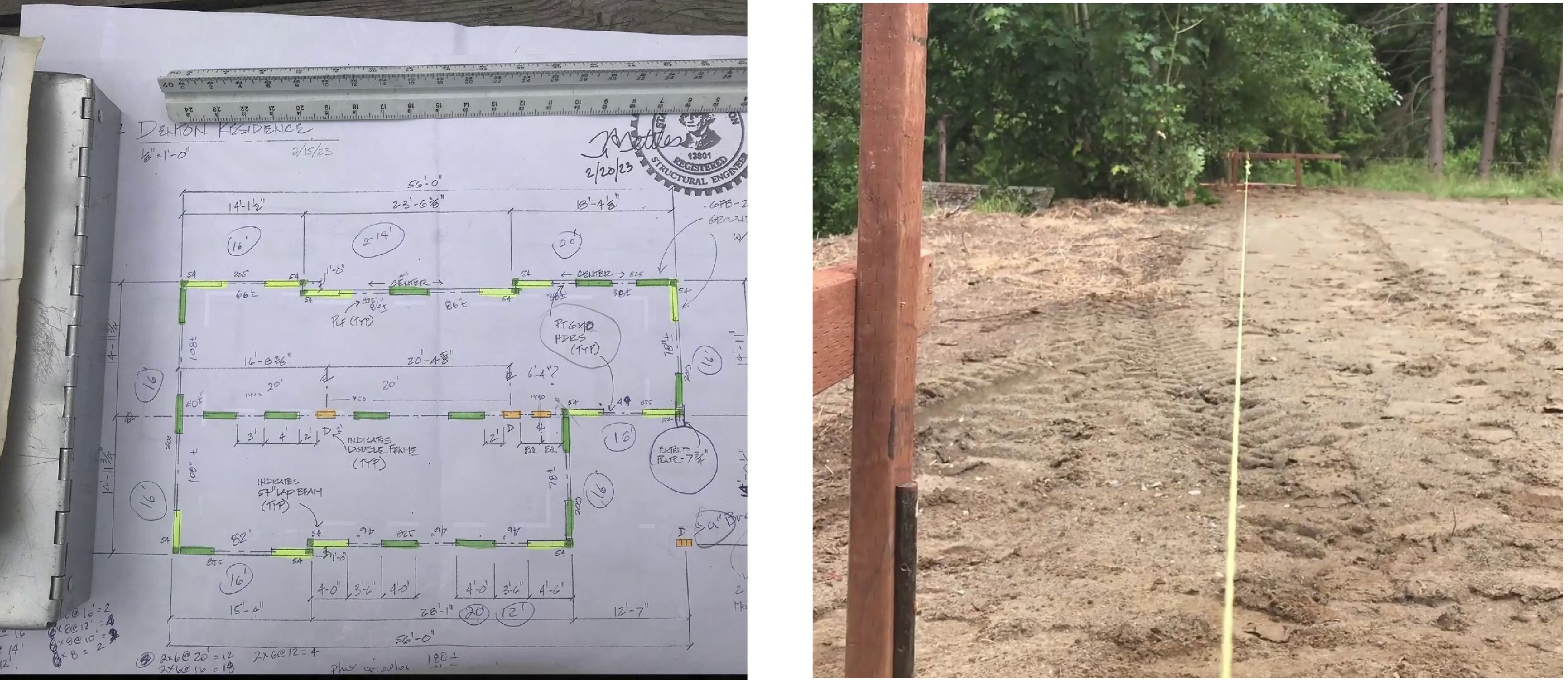
2. Using the dimensioned layout as a guide, establish the building border with a string line.

3. Measure diagonally to ensure the border is squared.
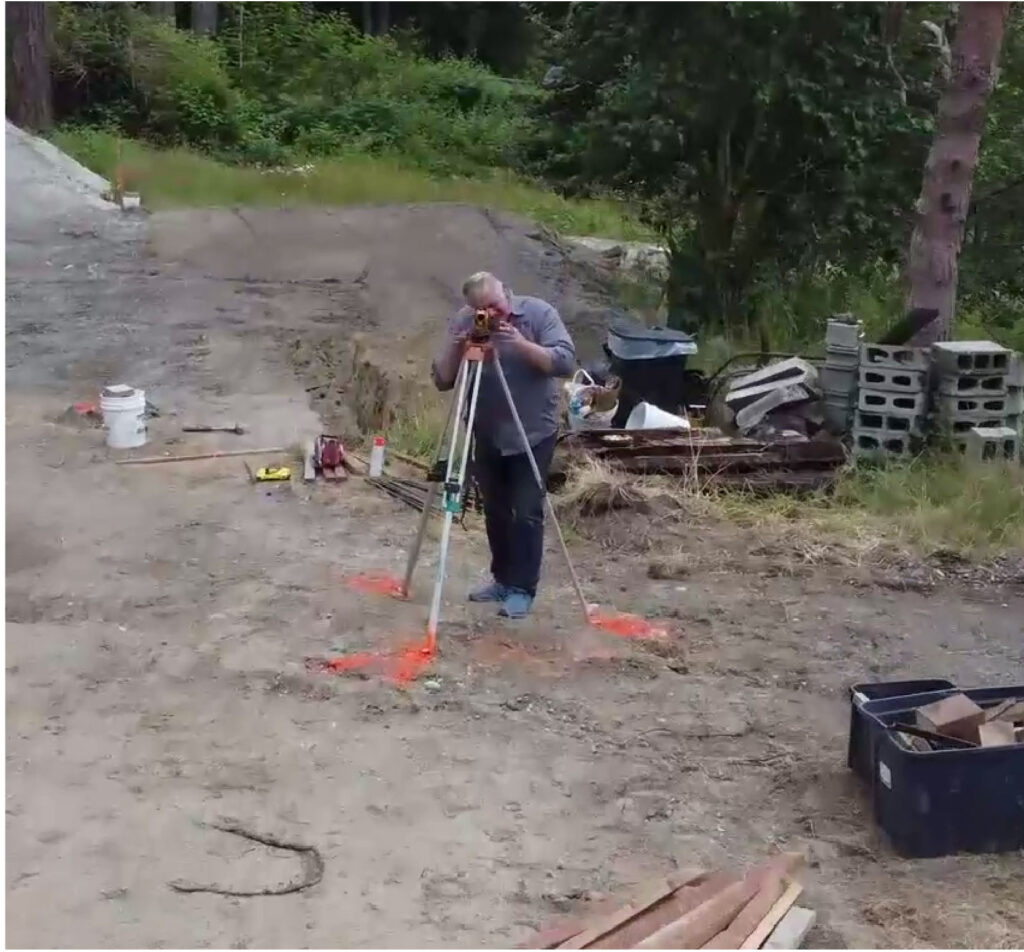
4. Find the elevation of a “Master Corner” (the highest corner).


5. Using the dimensioned layout, roughly stage the Ground Frame steel beams. It is best practice to start in the corners.

6. Block and shim the end of steel beams to the same level as the master corner. Minimum block height is 1.5” from master corner.

7. Maximum block height is 4”.

8. Ensure driving holes remain open and are not blocked by shims.


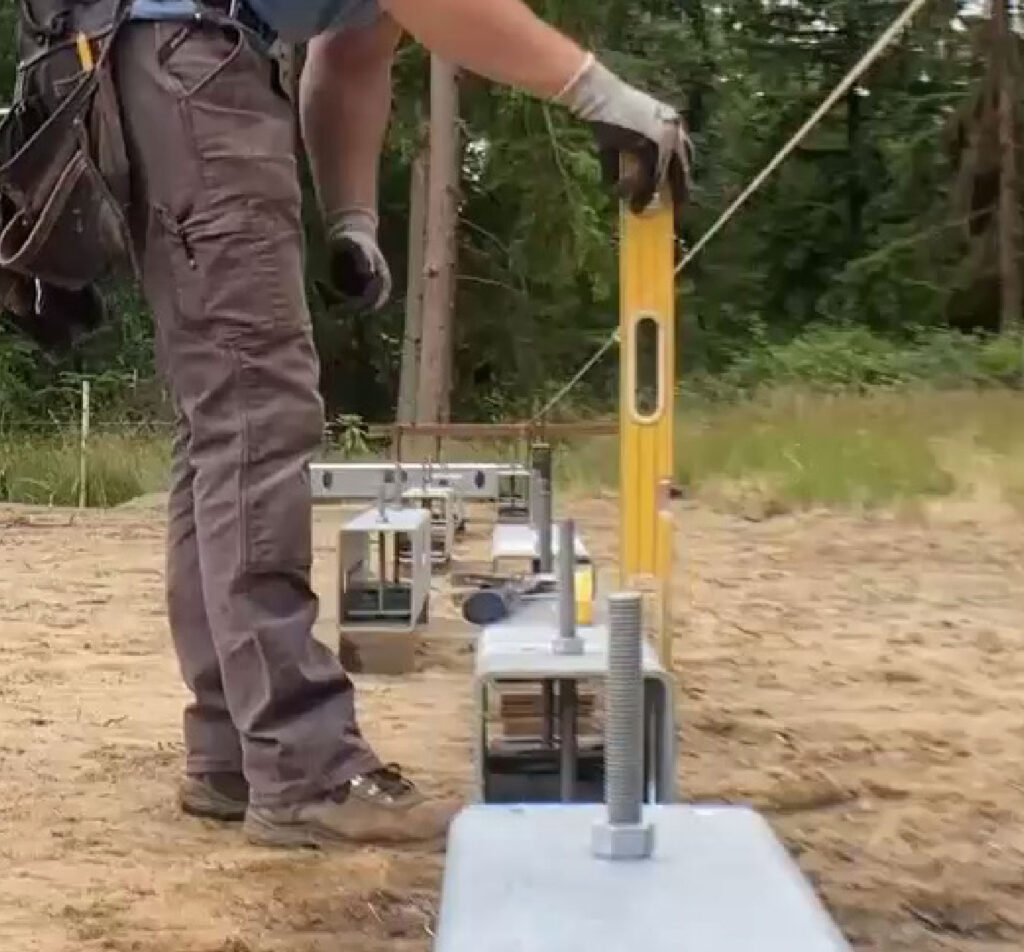
9. Ensure steel beams are properly aligned as per the dimensioned layout.
10. Verify all outer dimensions according to the dimensioned layout. Ensure steel beams are plumb, level, and square to the overall layout.
For sloped sites, see Sloped Addendum below.
SECURE AND BRACE SILL AND FRAMING BEAMS

11. Pre-drill the recommended 4” x 6” sill plates, using a ¾” bit, where the anchor bolts are located. It is best practice to start in the corners. Install header beam to the sill plate, prior to placing on steel beams.
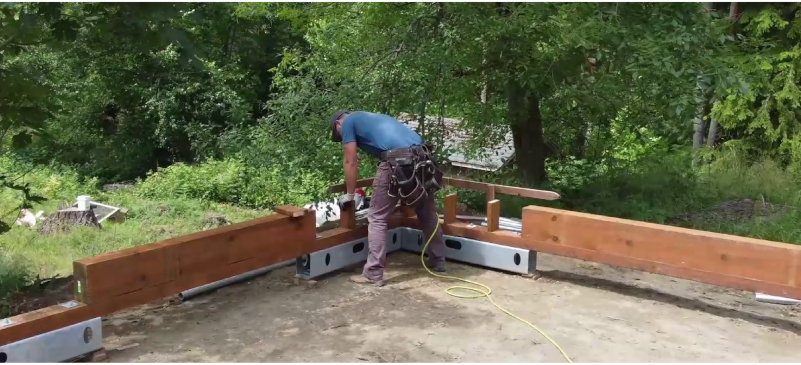
12. Place the pre-drilled sill plate and header beam over the anchor bolts.

13. Add the specified bearing plate, finger tighten the bolts.



14. When two Ground Frame steel beams meet at a corner, ensure that the sill plates overlap on top, in a manner that is opposite to the steel beams.

15. Continue installing the sill plates and headers.

16. Construct the pony walls on top of the sill plates using 2”x 6” cripplers as per the dimensioned plan. Frame pony walls off the sill plates to specified dimensions.

17. Double check your elevations and make any necessary adjustments.
PIPE INSTALLATION
![]() Ground Frame strongly recommends using a two-person crew for pipe driving.
Ground Frame strongly recommends using a two-person crew for pipe driving.
Ground Frame pipes are not refusal driving systems. All pipes must be driven to their full length to provide specified bearing, uplift and lateral capacities.

18. Upon framing completion, gather and stage Ground Frame pipes.

19. Ensure the pipe can easily slide through the side driving hole.
Important Note: If pipe does not easily slide, loosen the nut (on top of beam), lowering the force plate.

20. To ensure the pipe maintains the proper angle, hold it against the upper edge of the side driving hole.
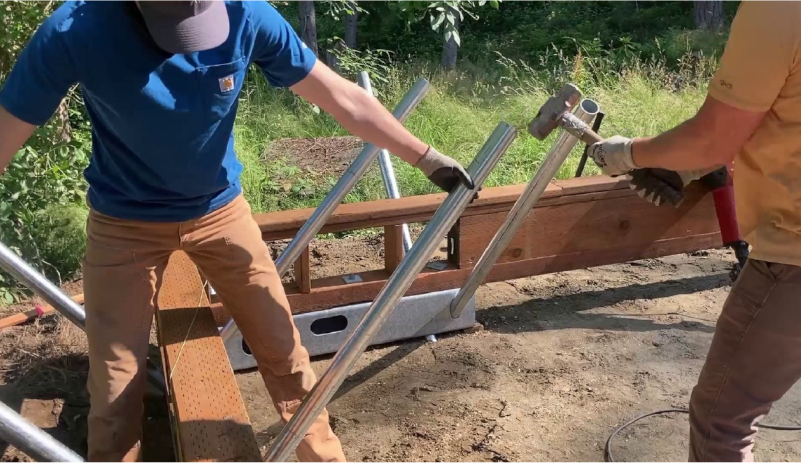
21. Using a sledgehammer, drive the pipe in a few inches, to maintain the proper angle.

22. Prepare the driving log.
Download Driving Log Template
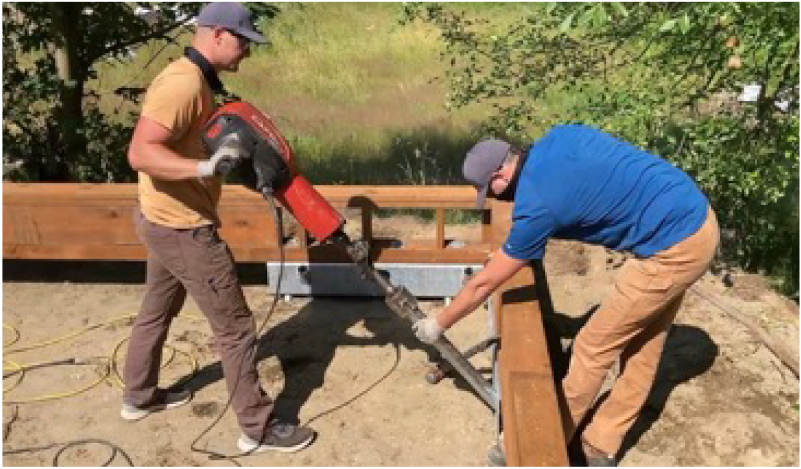
23. While holding the pipe up, drive the pipe through the side driving hole, using the jackhammer with the pipe driving bit.

24. Stop driving prior to bit hitting the beam.
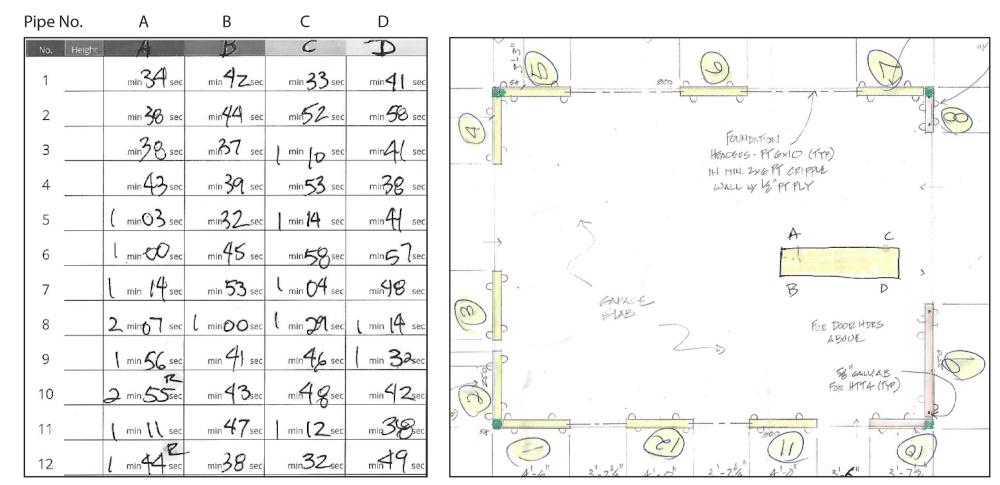
25. After each pipe installation note time in driving log.
Tip: Take dimensioned layout, number each beam, and denote the driving time for each side of the beam (A, B, C, D).

26. When pipe hits an obstruction, follow the troubleshooting steps found below.

27. Install pipe caps on top of each pipe.

28. Torque all bolts to 55 ft. lbs. Remove leveling blocks (installed in step 6-8) after torquing.
TROUBLESHOOTING
SHALLOW OBSTRUCTION: ~1/3 Pipe Length in the Ground

1. Remove pipe.
Tip: Simultaneously spin and pry pipe, using two pipe wrenches with two people.
2. Remove obstruction and recompact soil in 6” lifts.

3. Redrive pipe.
DEEP OBSTRUCTION: 2/3 Pipe Length in the Ground

1. Using a sledgehammer, strike the pipe, 3-5 blows, to ensure pipe refusal.
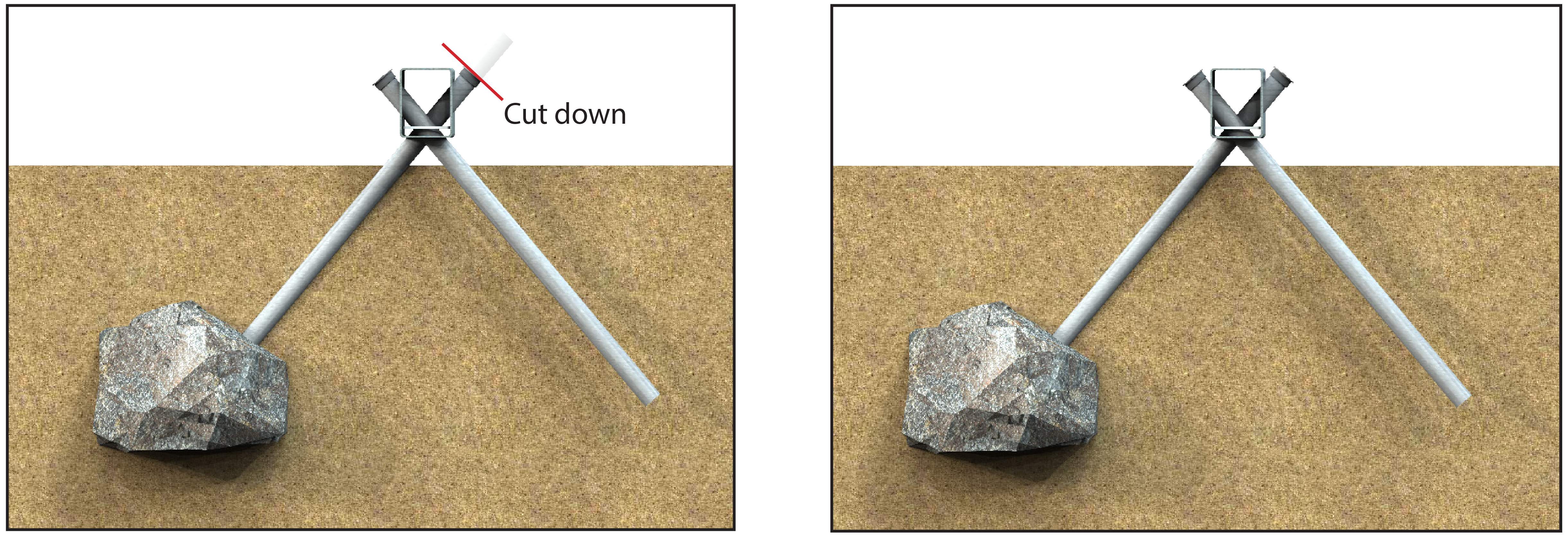

2. Cut the remaining portion of the pipe, above the Ground Frame beam, and cap.
Important Note: Indicate the length of the pipe that was cut off in the driving log.
Denote refusal (R) and indicate length of pipe that was cut.
SLOPED SITE ADDENDUM

Sloped lot with Ground Frame Beams


